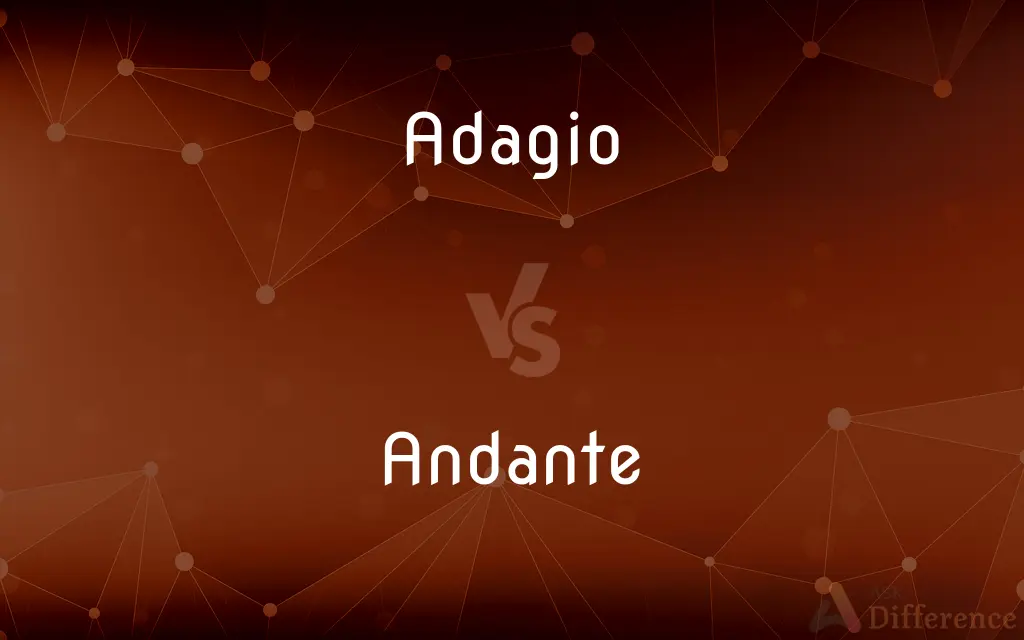Adagio vs. Andante — What's the Difference?
By Tayyaba Rehman & Fiza Rafique — Updated on March 18, 2024
Adagio and Andante are musical tempos, with Adagio being slow and expressive, typically slower than Andante, which denotes a moderately slow or walking pace.

Difference Between Adagio and Andante
Table of Contents
ADVERTISEMENT
Key Differences
Adagio is a tempo marking in music that indicates a piece should be played slowly and with great expression, often utilized in sections that require emotional depth and a leisurely pace. This tempo allows for greater expressiveness in the music, highlighting the melodic lines and harmonic changes. Whereas, Andante is slightly faster, suggesting a tempo that is moderate, akin to a leisurely walking pace. It is used in music to convey a sense of steady, continuous movement without the urgency of faster tempos or the pronounced slow pace of Adagio.
In terms of beats per minute (BPM), Adagio generally ranges from about 66 to 76 BPM, offering musicians the space to delve deeply into the expressive aspects of the music, emphasizing dynamics and phrasing. On the other hand, Andante is typically set between 76 and 108 BPM, balancing between too slow and too fast, providing a comfortable pace for both musicians and listeners, ideal for passages requiring clarity and motion.
Adagio passages are often found in slow movements of sonatas, symphonies, and concertos, where the emotional content of the music is foregrounded. The slow tempo allows for the exploration of complex emotional themes and intricate musical ideas. Andante, conversely, may be used in a variety of musical forms, often as a moderate, middle-ground tempo for movements that benefit from a more measured pace, neither too introspective nor too brisk.
In practice, the interpretation of Adagio and Andante can vary significantly depending on the context of the music, the composer's intentions, and the performer's perspective. While Adagio might be characterized by a broader, more expansive use of time, Andante focuses on a steady, unhurried progression that maintains a sense of flow and forward motion.
Understanding the distinction between Adagio and Andante is crucial for performers, as it affects the overall character and emotional impact of the music. While Adagio invites a deep, introspective exploration of the musical material, Andante offers a balance, providing momentum without losing the detail and expressiveness inherent in the piece.
ADVERTISEMENT
Comparison Chart
Tempo
Slow and expressive, typically slower than Andante.
Moderately slow, like a leisurely walking pace.
BPM Range
About 66 to 76 BPM.
About 76 to 108 BPM.
Emotional Quality
Deeply expressive, often used for emotional depth.
Balanced, conveying steady movement and clarity.
Common Usage
Slow movements in sonatas, symphonies, concertos.
Various musical forms, requiring moderate pace.
Performance
Allows for expressive phrasing and dynamics.
Focuses on clarity and steady, unhurried progression.
Compare with Definitions
Adagio
A slow, expressive tempo in music.
The adagio movement of the concerto allowed for a profound emotional expression.
Andante
A moderately slow tempo, like a walking pace.
The andante section provided a calm contrast to the preceding movement.
Adagio
Often used for sections requiring emotional depth.
The adagio passage in the symphony was hauntingly beautiful.
Andante
Ideal for movements needing steady flow.
The andante movement flowed smoothly, like a gentle stream.
Adagio
Can vary in interpretation but generally slow.
His interpretation of the adagio was slower, emphasizing its melancholy.
Andante
Maintains momentum without rushing.
She maintained an andante tempo, keeping the music flowing effortlessly.
Adagio
Indicates a tempo slower than Andante.
The piece transitions from an energetic allegro to a reflective adagio.
Andante
Versatile in use across musical forms.
The quartet's andante was well-paced, highlighting the interplay of the instruments.
Adagio
Allows for detailed phrasing and dynamics.
She played the adagio with such delicate nuance and control.
Andante
Faster than Adagio, offering balance.
After the adagio, the andante pace felt refreshing and lively.
Adagio
In a slow tempo, usually considered to be slower than andante but faster than larghetto. Used chiefly as a direction.
Andante
In a moderately slow tempo, usually considered to be slower than allegretto but faster than adagio. Used chiefly as a direction.
Adagio
(Music) A slow passage, movement, or work, especially one using adagio as the direction.
Andante
An andante passage or movement.
Adagio
A section of a pas de deux in which the ballerina and her partner perform steps requiring lyricism and great skill in lifting, balancing, and turning.
Andante
(music) A tempo mark directing that a passage is to be played in a moderately slow tempo; faster than adagio but slower than moderato.
Adagio
A succession of slow, fluid movements performed as an exercise in ballet.
Andante
(music) A passage having this mark.
Adagio
(music) A tempo mark directing that a passage is to be played rather slowly, leisurely and gracefully.
Andante
(music) Played at a moderately slow tempo.
Adagio
(music) A passage having this mark.
Andante
(music) Describing a passage having this mark.
Adagio
(dance) A male-female duet or mixed trio ballet displaying demanding balance, spins and/or lifts.
Andante
Moving moderately slow, but distinct and flowing; quicker than larghetto, and slower than allegretto.
Adagio
(music) Played rather slowly.
Andante
A moderately slow tempo (a walking pace)
Adagio
(music) Describing a passage having this mark.
Andante
(of tempo) moderately slow
Adagio
Slow; slowly, leisurely, and gracefully. When repeated, adagio, adagio, it directs the movement to be very slow.
Andante
At a moderately slow temp;
This passage must be played andante
Adagio
A piece of music in adagio time; a slow movement; as, an adagio of Haydn.
Adagio
(music) a composition played in adagio tempo (slowly and gracefully);
They played the adagio too quickly
Adagio
A slow section of a pas de deux requiring great skill and strength by the dancers
Adagio
(of tempo) leisurely
Adagio
Slowly;
Here you must play adagio
Common Curiosities
Can the tempo of Adagio vary?
Yes, the tempo of Adagio can vary depending on the composer's intentions, the context of the piece, and the performer's interpretation, though it remains within the slow tempo range.
Is Andante considered a slow tempo?
Andante is considered moderately slow, providing a steady pace that is not as slow as Adagio, allowing for clarity and motion in the music.
Why might a composer choose an Adagio tempo for a piece?
A composer might choose an Adagio tempo to highlight emotional depth, allow for expressive dynamics and phrasing, or explore complex musical themes at a leisurely pace.
How is Andante different from Adagio?
Andante is moderately slow, akin to a walking pace, and generally faster than the more leisurely and expressive Adagio, offering a balance between slow and fast tempos.
What does Adagio mean in music?
Adagio in music refers to a slow and expressive tempo, allowing for deep emotional expression and detailed musical phrasing.
What is the importance of tempo markings like Adagio and Andante in music?
Tempo markings like Adagio and Andante provide essential guidance on the pace and character of the music, influencing its emotional impact and overall expression.
How does a performer decide how to interpret Adagio or Andante?
A performer's interpretation of Adagio or Andante is influenced by the musical context, the composer's markings and intentions, historical performance practices, and personal artistic judgment.
Can Andante be used for fast-paced music?
Andante is not typically used for fast-paced music; it denotes a moderate tempo, but it can precede or follow faster sections within a piece.
Are there tempos slower than Adagio?
Yes, there are slower tempos than Adagio, such as Largo and Lento, which indicate even slower paces and more profound levels of expressiveness.
What types of music commonly use Andante?
Andante is used across various musical forms, including sonatas, symphonies, and chamber music, particularly in movements that benefit from a moderate pace.
Share Your Discovery

Previous Comparison
Pointe vs. Point
Next Comparison
Elderberry vs. ChokecherryAuthor Spotlight
Written by
Tayyaba RehmanTayyaba Rehman is a distinguished writer, currently serving as a primary contributor to askdifference.com. As a researcher in semantics and etymology, Tayyaba's passion for the complexity of languages and their distinctions has found a perfect home on the platform. Tayyaba delves into the intricacies of language, distinguishing between commonly confused words and phrases, thereby providing clarity for readers worldwide.
Co-written by
Fiza RafiqueFiza Rafique is a skilled content writer at AskDifference.com, where she meticulously refines and enhances written pieces. Drawing from her vast editorial expertise, Fiza ensures clarity, accuracy, and precision in every article. Passionate about language, she continually seeks to elevate the quality of content for readers worldwide.
















































